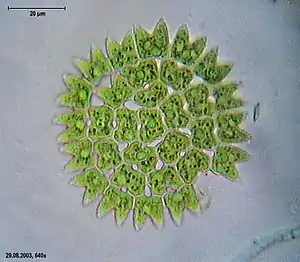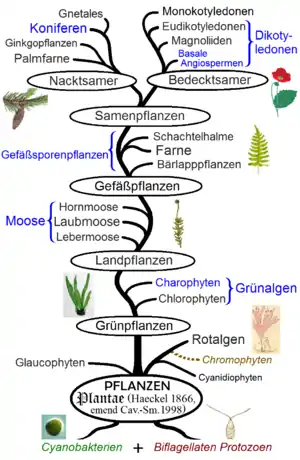Chloroplastida
Die Chloroplastida[1] oder Viridiplantae sind eine Gruppe von photosynthetisch aktiven Eukaryoten, also Lebewesen mit Zellkernen. Zu ihnen gehören die Grünalgen (Chlorophyta und Charophyta) und die Landpflanzen (Embryophyta).
| Chloroplastida | ||||||||||
|---|---|---|---|---|---|---|---|---|---|---|

| ||||||||||
| Systematik | ||||||||||
| ||||||||||
| Wissenschaftlicher Name | ||||||||||
| Chloroplastida | ||||||||||
| Adl et al., 2005 |
Merkmale
Die weitaus meisten Chloroplastida besitzen photosynthetisch aktive Plastiden mit Chlorophyll a und b, die Chloroplasten. Ausnahmen hiervon sind Organismen, die sekundär die Fähigkeit zur Photosynthese wieder verloren haben. Hierzu zählen beispielsweise die parasitisch lebende Vogel-Nestwurz oder die farblose Alge Polytoma.[2] Die Plastiden stammen von einer primären Endosymbiose mit einem Cyanobakterium. Häufig ist im Plastiden ein Pyrenoid vorhanden. Die Chloroplastida besitzen meistens eine Zellwand aus Zellulose. Die Cristae der Mitochondrien sind flach. Als Speicher-Kohlenhydrat dient Stärke. Mit Ausnahme der Angiospermen besitzen die Zellen Zentriolen[2].
Systematik

Innerhalb der Chloroplastida gibt es zwei große Kladen, die klar voneinander getrennt sind: die Chlorophyta und die Charophyta (zu denen auch die Embryophyta gehören). Sowohl die Chlorophyta als auch etliche Vertreter der Charophyta werden klassischerweise als Grünalgen bezeichnet. Damit ist der Begriff Grünalge nicht mehr für ein Taxon verwendbar.
Adl u. a. gliedern die Chloroplastida in folgende Gruppen ohne klassische Rangstufen:[3]
- Chlorophyta
- Ulvophyceae
- Trebouxiophyceae
- Chlorophyceae
- Pedinophyceae
- Mamiellophyceae
- Prasinophytae
- Chlorodendrophyceae
- Palmophyllales
- Nephroselmis
- Charophyta
- Klebsormidiophyceae
- Klebsormidium
- Entransia
- Interfilum
- Phragmoplastophyta
- Schmuckalgen (Zygnematophyceae)
- Coleochaetophyceae
- Streptophyta
- Armleuchteralgen (Charophyceae)
- Landpflanzen (Embryophyta)
- Mesostigma
- Chlorokybus
- Klebsormidiophyceae
Konsensus-Kladogramm
Nachfolgend ist eine Konsensrekonstruktion der Verwandtschaftsbeziehungen unter den Viridaeplantae, die hauptsächlich auf molekularen Daten basiert.[4][5][6][7][8][9][3][10][11][12]
| Viridiplantae |
| ||||||||||||||||||||||||||||||||||||||||||||||||||||||
| ••• Chlorophyta |
| ||||||||||||||||||||||||||||||||||||||||||||||||||||||||||||||||||||||||
Hier sind die Armleuchteralgen basal in den Phragmoplastophyta. Versteht man die Streptophyta als kleinstes die Armleuchteralgen und Landpflanzen enthaltenes Taxon, dann fallen diese mit den Phragmoplastophyta zusammen. Die Mesotaeniaceae stehen extra, sie werden herkömmlich in die Ordnung der Zieralgen (Desmidiales) innerhalb der Zygnematophyceen (Schmuckalgen) gestellt.
Literatur
- Louise A. Lewis, Richard M. McCourt: Green Algae and the origin of land plants: American Journal of Botany 91 (10), 2004, Seiten 1535–1556. Abstract und Volltext
Einzelnachweise
- Sina M. Adl, Alastair G. B. Simpson, Mark A. Farmer, Robert A. Andersen, O. Roger Anderson, John A. Barta, Samual S. Bowser, Guy Bragerolle, Robert A. Fensome, Suzanne Fredericq, Timothy Y. James, Sergei Karpov, Paul Kugrens, John Krug, Christopher E. Lane, Louise A. Lewis, Jean Lodge, Denis H. Lynn, David G. Mann, Richard M. McCourt, Leonel Mendoza, Øjvind Moestrup, Sharon E. Mozley-Standridge, Thomas A. Nerad, Carol A. Shearer, Alexey V. Smirnov, Frederick W. Spiegel, Max F. J. R. Taylor: The New Higher Level Classification of Eukaryotes with Emphasis on the Taxonomy of Protists. The Journal of Eukaryotic Microbiology 52 (5), 2005; Seiten 399–451. doi:10.1111/j.1550-7408.2005.00053.x.
- Sitte, P. et al. (1991): Lehrbuch der Botanik für Hochschulen. 33. Auflage. Gustav Fischer Verlag
- Adl SM, Simpson AG, Lane CE, Lukeš J, Bass D, Bowser SS, Brown MW, Burki F, Dunthorn M, Hampl V, Heiss A, Hoppenrath M, Lara E, Le Gall L, Lynn DH, McManus H, Mitchell EA, Mozley-Stanridge SE, Parfrey LW, Pawlowski J, Rueckert S, Shadwick L, Shadwick L, Schoch CL, Smirnov A, Spiegel FW: The revised classification of eukaryotes. In: The Journal of Eukaryotic Microbiology. 59, Nr. 5, September 2012, S. 429–493. doi:10.1111/j.1550-7408.2012.00644.x. PMID 23020233. PMC 3483872 (freier Volltext). PDF Online
- Lewis LA, McCourt RM: Green algae and the origin of land plants. In: American Journal of Botany. 91, Nr. 10, Oktober 2004, S. 1535–1556. doi:10.3732/ajb.91.10.1535. PMID 21652308.
- Leliaert F, Smith DR, Moreau H, Herron MD, Verbruggen H, Delwiche CF, De Clerck O: Phylogeny and molecular evolution of the green algae. In: Critical Reviews in Plant Sciences. 31, 2012, S. 1–46. doi:10.1080/07352689.2011.615705.
- Marin B: Nested in the Chlorellales or independent class? Phylogeny and classification of the Pedinophyceae (Viridiplantae) revealed by molecular phylogenetic analyses of complete nuclear and plastid-encoded rRNA operons. In: Protist. 163, Nr. 5, September 2012, S. 778–805. doi:10.1016/j.protis.2011.11.004. PMID 22192529.
- Laurin-Lemay S, Brinkmann H, Philippe H: Origin of land plants revisited in the light of sequence contamination and missing data. In: Current Biology. 22, Nr. 15, August 2012, S. R593–4. doi:10.1016/j.cub.2012.06.013. PMID 22877776.
- Ruhfel BR, Gitzendanner MA, Soltis PS, Soltis DE, Burleigh JG: From algae to angiosperms-inferring the phylogeny of green plants (Viridiplantae) from 360 plastid genomes. In: BMC Evolutionary Biology. 14, Februar 2014, S. 23. doi:10.1186/1471-2148-14-23. PMID 24533922. PMC 3933183 (freier Volltext).
- Leliaert F, Tronholm A, Lemieux C, Turmel M, DePriest MS, Bhattacharya D, Karol KG, Fredericq S, Zechman FW, Lopez-Bautista JM: Chloroplast phylogenomic analyses reveal the deepest-branching lineage of the Chlorophyta, Palmophyllophyceae class. nov. In: Scientific Reports. 6, Mai 2016, S. 25367. doi:10.1038/srep25367. PMID 27157793. PMC 4860620 (freier Volltext).
- Sánchez-Baracaldo P, Raven JA, Pisani D, Knoll AH: Early photosynthetic eukaryotes inhabited low-salinity habitats. In: Proceedings of the National Academy of Sciences of the United States of America. 114, Nr. 37, September 2017, S. E7737–E7745. doi:10.1073/pnas.1620089114. PMID 28808007. PMC 5603991 (freier Volltext).
- Gitzendanner MA, Soltis PS, Wong GK, Ruhfel BR, Soltis DE: Plastid phylogenomic analysis of green plants: A billion years of evolutionary history. In: American Journal of Botany. 105, Nr. 3, März 2018, S. 291–301. doi:10.1002/ajb2.1048. PMID 29603143.
- Matthias Riediger, Yukako Hihara, Wolfgang R. Hess: From cyanobacteria and algae to land plants: The RpaB/Ycf27 regulatory network in transition. In: Perspectives in Phycology. 5, Nr. 1, 1. Juni 2018, ISSN 2198-011X, S. 13–25. doi:10.1127/pip/2018/0078.